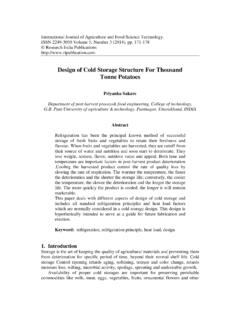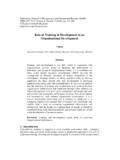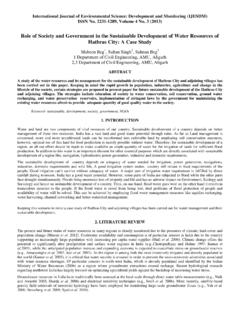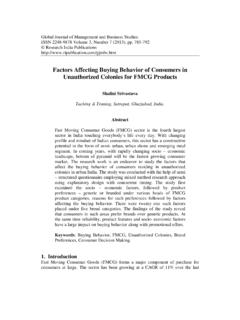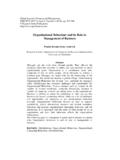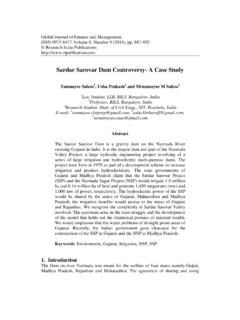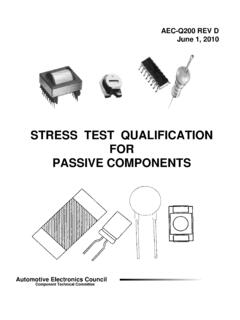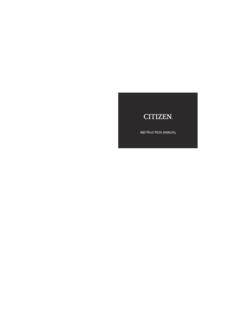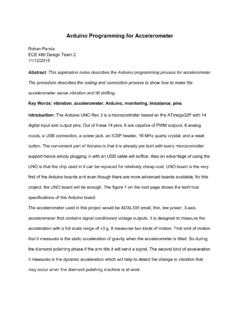Transcription of Water Quality Monitoring System Based on IOT
1 Advances in Wireless and Mobile Communications. ISSN 0973-6972 Volume 10, Number 5 (2017), pp. 1107-1116 Research India Publications Water Quality Monitoring System Based on IOT Vaishnavi V. Daigavane and Dr. Gaikwad Department Electronics & Telecommunication Engineering, Mtech(VLSI), Bapurao Deshmukh College of Engineering, Sevagram, wardha_442102( ), India. Abstract Water pollution is one of the biggest fears for the green globalization. In order to ensure the safe supply of the drinking Water the Quality needs to be monitor in real time.
2 In this paper we present a design and development of a low cost System for real time Monitoring of the Water Quality in IOT(internet of things).The System consist of several sensors is used to measuring physical and chemical parameters of the Water . The parameters such as temperature, PH, turbidity, flow sensor of the Water can be measured. The measured values from the sensors can be processed by the core controller. The Arduino model can be used as a core controller. Finally, the sensor data can be viewed on internet using WI-FI System .
3 Keyword: pH sensor, Turbidity sensor, Temperature sensor, Flow sensor, Ardurino model, WI-FI module. I. INTRODUCTION: In the 21st century, there were lots of inventions, but at the same time were pollutions, global warming and so on are being formed, because of this there is no safe drinking Water for the world s pollution. Nowadays, Water Quality Monitoring in real time faces challenges because of global warming limited Water resources, growing population, etc. Hence there is need of developing better methodologies to monitor the Water Quality parameters in real time[1].
4 The Water Quality parameters pH measures the concentration 1108 Vaishnavi V. Daigavane and Dr. Gaikwad of hydrogen ions. It shows the Water is acidic or alkaline. Pure Water has 7pH value, less than 7pH has acidic, more than 7pH has alkaline. The range of pH is 0-14 pH. For drinking purpose it should be Turbidity measures the large number of suspended particles in Water that is invisible. Higher the turbidity higher the risk of diarrheoa, collera. Lower the turbidity then the Water is clean.
5 Temperature sensor measures how the Water is, hot or cold. Flow sensor measures the flow of Water through flow sensor. The traditional methods of Water Quality monitor involves the manual collection of Water samples from different locations. The rest of this paper is organised as follows: section II review the related work of this project, section III describes the proposed System with the modules explanation, section IV provides the Schematic circuit with it working, Section V shows the results and discussion, section VI the conclusion with future scope.
6 II. LITERATURE REVIEW Nikhil Kedia entitled Water Quality Monitoring for Rural Areas-A Sensor Cloud Based Economical Project. Published in 2015 1st International Conference on Next Generation Computing Technologies (NGCT-2015) Dehradun, India. This paper highlights theentire Water Quality Monitoring methods, sensors, embedded design, and information dissipation procedure, role of government, network operator and villagers in ensuring proper information dissipation. It also explores the Sensor Cloud domain.
7 While automatically improving the Water Quality is not feasible at this point, efficient use of technology and economic practices can help improve Water Quality and awareness among people.[1] Jayti Bhatt,Jignesh Patoliya entitled Real Time Water Quality Monitoring System .This paper describes to ensure the safe supply of drinking Water the Quality should be monitored in real time for that purpose new approach IOT (Internet of Things) Based Water Quality Monitoring has been proposed.
8 In this paper, we present the design of IOT Based Water Quality Monitoring System that monitor the Quality of Water in real time. This System consists some sensors which measure the Water Quality parameter such as pH, turbidity, conductivity, dissolved oxygen, temperature. The measured values from the sensors are processed by microcontroller and this processed values are transmitted remotely to the core controller that is raspberry pi using Zigbee protocol. Finally, sensors data can view on internet browser application using cloud computing.
9 [2] Michal Lom, Ondrej Pribyl, Miroslav Svitek entitled Industry as a Part of Smart Cities . This paper describes the conjunction of the Smart City Initiative and the concept of Industry The term smart city has been a phenomenon of the last years, which is very inflected especially since 2008 when the world was hit by the financial crisis. The main reasons for the emergence of the Smart City Initiative are to create a sustainable model for cities and preserve Quality of life of their citizens.
10 The topic of the smart city Water Quality Monitoring System Based on IOT 1109 cannot be seen only as a technical discipline, but different economic, humanitarian or legal aspects must be involved as well. In the concept of Industry , the Internet of Things (IoT) shall be used for the development of so called smart products. Sub-components of the product are equipped with their own intelligence. Added intelligence is used both during the manufacturing of a product as well as during subsequent handling, up to continuous Monitoring of the product lifecycle (smart processes).
